The Dogs of War is the penultimate episode of Star Trek: Deep Space Nine.
As such, it has lots of important things to be doing. The episode’s primary function is to streamline the ongoing narratives so that they might all neatly feed into What You Leave Behind. The goal of any penultimate episode is to set up the shot so that the finale might punt the ball into the goal, in a manner that leads to a satisfying conclusion. Given that The Dogs of War is arriving towards the end of a seven-season series, a two-year war story, and a ten-episode closing arc, that is a lot of setting up to be done.

The best is Yates to come.
There is a lot of work to be done on paper. The plot thread focusing on the Pah-Wraiths has been dangling since When It Rains…, the Federation has not reengaged with the Breen since the disastrous encounter at the end of The Changeling Face of Evil, and Bajor hasn’t even mentioned the possibility of joining the Federation since Rapture or In the Cards. With that in mind, it makes perfect sense of The Dogs of War to focus on getting Bashir and Dax together while Quark thinks he is about to be Nagus as Damar is forced to hide in a cellar.
However, there is something inherently charming about how The Dogs of War chooses to prioritise threads over story beats that might seem more relevant or important, to dedicate a sizable chunk of the penultimate episode of Deep Space Nine to tying up a clumsy “will they?”/“won’t they?” romance and telling one last Ferengi story. The Dogs of War is an episode that speaks to what Deep Space Nine was, both in terms is esoteric plotting and its skewed-but-optimistic outlook. There might be better ways to wind down a series, but this is very Deep Space Nine.

Love in a turbolift.
That said, it is easy to exaggerate the size of the Ferengi plot in The Dogs of War when discussing the episode. There is a tendency to think of The Dogs of War as “a Ferengi episode” in the same way that The Nagus or Rules of Acquisition or Family Business are “Ferengi episodes.” Certainly, a lot of contemporary discussion of the episode treated it as the “last Ferengi episode ever.” This makes sense, given the episode’s focus on Ferengi society and its use of the recurring Ferengi guest cast.
At the same time, the Ferengi subplot within The Dogs of War is relatively self-contained. It does not feature in the teaser, which introduces the USS Sao Paolo and sets up the destruction of Damar’s resistance movement. In fact, The Dogs of War does not shift its focus to the Ferengi characters until twelve minutes into the episode. By that point, writes Ronald D. Moore and René Echevarria have already got Damar into the cellar and dealt with the clumsy fallout regarding Section 31’s attempt genocide that probably should have been explored in Extreme Measures.

No need to get bent out of shape.
Even then, The Dogs of War is relatively contained. Wallace Shawn only appears in two scenes of the episode, the early scene where Zek confuses Quark with Rom and the later scene where he clears up the confusion. Ishka and Maihar’du only appear in that second scene. Although Nog appears, he only speaks three lines over the course of the entire episode. Even Quark’s central arc is abridged, with ever Quark-centric scene in the episode feeling like a bullet-point on a character arc.
This might not be the worst thing. The weakest Ferengi episodes tend to be those with with the broadest premises, lacking clear focus and drive. Prophet Motive is one such example, an old sitcom script that was awkwardly reworked to focus on the Ferengi. Profit and Lace is another example, an episode that is never entirely sure what it is supposed to be about beyond a clumsy attempt at classic farce. The Emperor’s New Cloak finds a couple of half-decent jokes stretched to breaking point. The Dogs of War affords its Ferengi characters a very clear purpose.
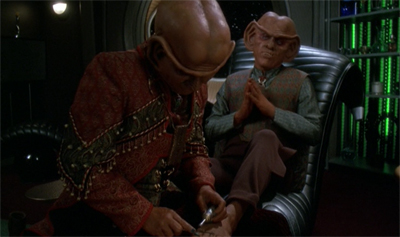
No mean feet.
Indeed, The Dogs of War is a Ferengi episode in that its only self-contained story thread centres on the Ferengi. The mistaken identity plot is the only story in The Dogs of War that has a clear beginning, middle and end. Odo’s outrage over Section 31’s attempted genocide is carried over from the central plot of Extreme Measures. The relationship between Dax and Bashir is paying off a simmering plot thread dangling since ‘Til Death Do Us Part. The various military subplots, including Damar’s defeat, all set up What You Leave Behind.
In contrast, the Ferengi plot within The Dogs of War has a clear three-act structure with a very clear set-up, escalation and resolution; Quark believes that he is going to be Nagus, then discovers what being Nagus would involve, then discovers that Rom was meant to be Nagus. It is similar to the handling of the Klingon-centric plot in When It Rains… and Tacking Into the Wind or of the O’Brien and Bashir plot within Extreme Measures. While The Dogs of War is not a satisfying single episode of television on its own terms, it does tell at least one complete story.
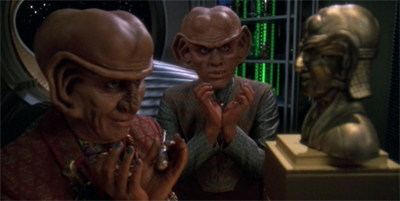
“I pray this works out better than Profit and Lace.”
In fact, it is impossible to imagine Deep Space Nine wrapping up without offering some sense of closure or resolution to the Ferengi Alliance. The Ferengi were a vital and important part of Deep Space Nine, dating back to the very first season of the show. Ira Steven Behr worked hard to establish his own footprint on Deep Space Nine, and he did so through episodes like The Nagus. Behr’s decision to focus on the Ferengi was a bold statement of purpose, to take a mess created by Star Trek: The Next Generation and try to fashion it into something interesting and compelling.
Naturally, the Ferengi remain controversial among certain segments of Star Trek fandom. The Ferengi episodes were not always good; episodes like Rules of Acquisition and Ferengi Love Songs were underwhelming to say the least. In fact, several of these episodes were among the worst that Deep Space Nine had to offer; Prophet Motive, Profit and Lace, The Emperor’s New Cloak. This is to say nothing of the Ferengi episodes outside of Behr’s purview, like False Profits on Star Trek: Voyager or Acquisition on Star Trek: Enterprise.
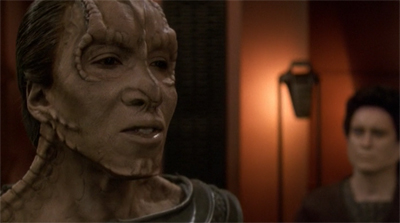
Going for Broca.
However, over the course of Deep Space Nine, the Ferengi characters became capable of anchoring both comedy and drama. Quark developed into one of the more compelling and intriguing members of the ensemble, as demonstrated in episodes like The Ascent or The Siege of AR-558. Ferengi-centric episodes like The House of Quark, Little Green Men and The Magnificent Ferengi counted among the funniest episodes in the franchise. At the same time, episodes like Family Business, Bar Association and Body Parts made the Ferengi a source of compelling drama.
As such, the Ferengi have earned some measure of resolution at the end of these seven seasons, some sense of closure to their story. The Dogs of War aims to provide a fitting closing chapter to the story of the Ferengi, just as Tacking Into the Wind wrapped up over a decade of Klingon stories or What You Leave Behind draws down the curtain on the tragedy of the Cardassian Union. The Dogs of War is aware of this weight upon it. Quark’s dialogue calls back more than a decade to The Last Outpost, wherein actor Armin Shimerman established the Ferengi.

Barring disaster.
In many ways, the Ferengi serve as just another way for the Deep Space Nine writers to play with the expectations of the Star Trek franchise. The development of the greedy caricatures from The Last Outpost into a fully developed alien species by The Dogs of War seems almost like a sly parody of franchise world-building, the broad comedy of Ferengi culture affectionately spoofing the more conventional development of the Klingon Empire. Indeed, The House of Quark plays this contrast for laughs.
Even within The Dogs of War, there is a sense that writers Ronald D. Moore and René Echevarria are having fun with these characters. When Quark discovers how profoundly Zek has reformed Ferengi society, he boldly proclaims, “The line has to be drawn here. This far and no further!” It is an affectionate nod to Patrick Stewart’s most iconic moment in Star Trek: First Contact. Moore acknowledged the similarity, conceding, “I take great glee at mocking my own work. See also In the Cards for a riff on Picard’s rather pompous ‘we don’t need money’ line.”

“I also do Moby Dick reading.”
Interestingly, according to The Star Trek: Deep Space Nine Companion, the Ferengi-centric plot changed a great deal during the development process:
“It’s the one that changed the most and worked the best,” says Echevarria. The premise, which Behr attributes to a Paramount exec, was “Wouldn’t it be nice if Rom became the nagus?”
“Lots of people like Rom,” says Behr. “I though it was a really good idea. Obviously, we’d played around with the idea of Quark becoming nagus, but that was wrong. Quark had to be in that bar at the end of the show. I felt that the audience needed that continuity even more than whoever was going to run the station. Quark is the centre of the station – and I needed that centre. So we couldn’t make Quark nagus.”
While The Dogs of War offers some sense of closure to the story of the Ferengi Alliance, Quark’s story does not conclude until the very end of What You Leave Behind.
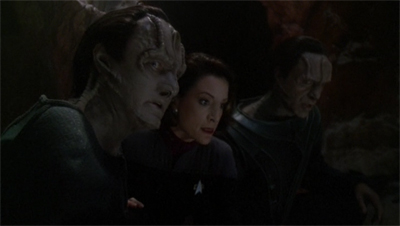
The beginning of the end.
Quark’s story is no longer the story of the Ferengi Alliance, but then perhaps it never was. There has always been something deeply tragic about Quark’s relationship to Ferenginar, mirroring the tension that exists between Worf and Qo’nos or the dynamic at play between Garak and Cardassia. These characters are all exiles and outcasts, figuratively if not literally. Deep Space Nine repeatedly suggests that these characters are not really representative of their species, even as they aspire to romantic ideals of what they should be.
These are all characters who have espoused the ideals of their homeland. Worf is arguably more Klingon than most Klingons, carefully observing ancient rituals and trying to live his life according to a code of honour that many of his compatriots have long forgotten. Garak spends most of his early appearances espousing the virtues of Cardassian civilisation, even going so far as to suggest that Bajor might have benefited from the Occupation in Things Past. Quark aspires towards greed and avarice as Ferengi ideals. However, there is a sense of dissonance to these three.

You can go home again.
Worf accepted dishonour for the greater good in Sins of the Father, while Garak confessed multiple secret shames in The Wire and proved unable to stomach his work in The Die is Cast. Quark broke a contract with a fellow Ferengi in Body Parts, and the series has repeatedly suggested that Quark has more of a conscience than he would ever admit. Over the course of this final arc, each of these three characters is forced to confront what their society has become, and to reconcile the differences between what they thought it was and what it really is.
There is also something tragic in all of this. Over the course of these ten episodes, characters are repeatedly forced to confront the reality of change and evolution, in spite of their romantic ideals about their homeland. In Tacking Into the Wind, both Damar and Worf are forced to accept the Cardassian Union and the Klingon Empire must change, and that things cannot go on as they have been. In Tacking Into the Wind, Damar incorporates these sentiments into a eulogy for Rusot. “He was my friend. But his Cardassia’s dead, and it won’t be coming back.”

Rebel base(ment).
As Deep Space Nine comes to a close, these exiles and outcasts get to witness important transitions. Worf assassinates Gowron in Tacking Into the Wind, facilitating Martok’s ascension to the High Chancellorship. Garak returns home to Cardassia in When It Rains…, helping Damar run a resistance movement against the Dominion. Garak’s childhood home becomes the last headquarters of this resistance movement early in The Dogs of War. In that same episode, Quark is present for the transition of power from Grand Nagus Zek to Grand Nagus Rom.
Naturally, Quark is resistant to change. He is horrified at the prospect of increased financial regulation. “Whatever happened to survival of the fittest?” Quark demands. “Whatever happened to the rich getting richer and the poor getting poorer? Whatever happened to pure, unadulterated greed?” Brunt simply replies, “Things change.” Quark shrugs off that observation. “And they’re going to change back. The first thing I’m going to do is eliminate these so called reforms, before Ferenginar ends up looking like a Federation planet.” Of course, it is not so easy.
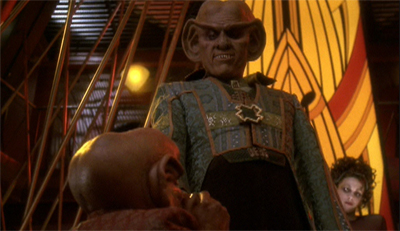
Negging the Nagus.
There is an irony in all of this. The final ten episodes of Deep Space Nine repeatedly suggest that these characters operate at a remove from their societies and their cultures. Worf might valourise Klingon honour culture, but does he really understand the Empire? “Who was the last leader of the High Council that you respected?” Dax asked in Tacking Into the Wind. “Has there even been one?” In that same episode, Damar processes the execution of his family. “What kind of people give those orders?” he ponders, only slowly realising the irony of his question.
In The Dogs of War, Quark goes through something of a similar arc. While Brunt is desperately sucking up to him, Quark discovers that Grand Nagus Zek has implemented a policy of liberalisation. He is horrified to hear about the checks and balances that have been put in place. Of course, as Brunt suggests, there is some irony in Quark’s outrage over these social changes. “You haven’t been keeping up with the latest reforms, have you?” Brunt wonders. “Zek instituted progressive income tax three months ago.”

A taxing conversation.
For all Quark’s patriotic bluster about making his bar “the last outpost of what made Ferenginar great”, he seems curiously disengaged with its politics. Does Quark understand Ferenginar in any concrete sense? Is Quark’s notion of his home planet informed by anything more than an abstract and romantic ideal? After all, it isn’t as though these reforms came from nothing. The events of Ferengi Love Songs and Profit and Lace made it clear that Zek was liberalising Ferengi culture. How could Quark be so out of touch? It is a wonderfully bitter character beat.
The Dogs of War suggests that Ferengi culture is liberalising, moving away from the gross caricature of unchecked capitalism introduced in The Last Outpost and developed over the next decade or so of stories. There is a sense that these reforms are necessary. Early in the episode, Zek has trouble getting a message to Deep Space Nine. “There was an accident at the power plant,” he explains. “The contractor used substandard relays, the greedy bastard. There’s a toxic electrostatic cloud hanging over the city. What a frigging mess.”
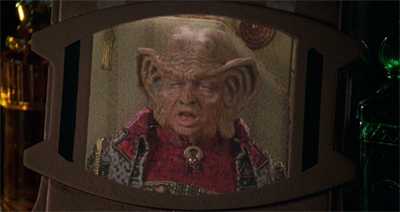
What the Zek is going on?
Deep Space Nine has a reputation for being the most cynical Star Trek series, but is also one of the most aggressively liberal. The production team might have worked hard to introduce the concept of money into the twenty-fourth century and to explore the idea of a post-scarcity economy in episodes like In the Cards or Treachery, Faith and the Great River, but the show also bristles angrily about social injustice in episodes like Past Tense, Part I and Past Tense, Part II.
The Dogs of War suggests that these Ferengi reforms are a step in the right direction. For all that Deep Space Nine clearly loves the Ferengi, the show has never been shy about condemning their cultural mores. The series might have struggled to strike the right balance in episodes like Profit and Lace, but there is a clear sense that Ferengi culture is too reckless and too driven by money. Quark and Rom banter about Zek’s reforms in the bar, and Rom gets to defend every major policy plank.

Dealing with it.
“What’s the point of being in business if you can’t corner the market and gouge your customers?” Quark wonders. Rom responds, “There’s something to be said for keeping prices down by ensuring healthy competition.” Quark complains, “You can’t even dump industrial waste anymore because it might harm the natural habitat.” Rom replies, “I suppose you could argue that Ferenginar’s biodiversity is a precious resource that belongs to everyone.” Quark continues, “What have we come to if you can’t demand sexual favors from people in your employ?” Rom explains, “Unharassed workers are productive workers.“
This reformation of Ferengi is very much in keeping with how Deep Space Nine approaches its alien cultures in the run-up to What You Leave Behind. Qo’nos, Cardassia and Ferenginar are all radically reformed over the course of these ten episodes. However, the form and function of these reforms is quite similar. In each case, Deep Space Nine makes a point to shift power away from the established ruling class towards those who exist on the margins of that same society.
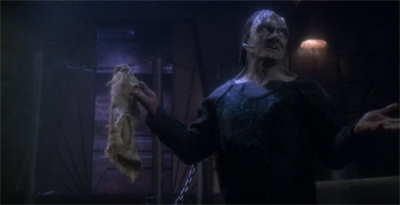
Cleaning up his act.
Once More Unto the Breach made a point to emphasise Martok’s background as a member of the working class, something that he reiterated in Tacking Into the Wind. In The Dogs of War, the leaders of the resistance find themselves hiding in a cellar, reduced to menial chores. “Well, you might as well make yourselves useful,” Mila reflects. “This place hasn’t been cleaned in years.” Garak smiles, “The glamour of being a revolutionary.” In What You Leave Behind, it is suggested that Garak will play a role leading Cardassia; an exiled bastard tailor.
More than any other Star Trek show, Deep Space Nine was invested in the lives of those on the margins. It seems entirely appropriate that Damar should be forced to hide in an old woman’s cellar. “We’re attempting to free our people,” he appeals. “Do you want to live under the Dominion for the rest of your life?” Damar speaks of empires and galactic wars. This is of no concern to a woman who spent most of her life as a housekeeper, a woman implied to have been forced to deny her own son. “I’m an old woman. I’m long past caring about such things.”

A Mila miles away from such concerns.
With this in mind, it makes sense that Zek and Ishka should settle upon Rom to inherit the Ferengi Alliance. After all, Rom is an honest working-class Ferengi. He spent a long time working at the bar, under his brother’s thumb. He then left and became an engineer working on a space station run by a foreign power. Rom is not a member of the upper class. Rom is not even a particularly active member of Ferengi culture. However, he is a decent and hardworking individual who did not inherit his position by birth or social class.
(Of course, there are any number of questions stemming from Zek’s decision to name Rom as his successor. The most obvious is that Rom has no real experience in this sort of role. Unlike Martok or Garak, Rom has no political background upon which he might draw. More than that, Rom is trusting and sincere. This would seem to make him easy prey from somebody like Brunt; but smarter, of course. “You know, I could use a financial advisor,” Rom confesses. Quark replies, “No kidding.” It is interesting to imagine Rom’s first year in the job.)

The hard buy.
It is worth noting that these changes to Cardassian, Klingon and Ferengi culture all come from within. They are all driven by grassroots movements within these cultures; they might be abetted and supported by the Federation, but they are internal changes. This reflects a certain school of political thought, as articulated by Ethopian Prime Minister Meles Zenaway:
We believe democracy cannot be imposed from outside in any society. Democracy is the expression of a sovereign people. To impose it from outside is inherently undemocratic. Each sovereign nation has to make its own decisions and have its own criteria as to how they govern themselves.
Indeed, this is one of the central tensions within liberal democracies. Liberal democracies believe that concepts like human rights are universal, that every person on the planet deserves protection. However, it can be difficult to enforce that belief, as not all countries recognise the existence of these fundamental rights. So how can these ideas be spread and shared without engaging in cultural imperialism or direct intervention?

Everything burns.
Given that Star Trek is an extrapolation of liberal and democratic idealism into the distant future, it makes sense that the franchise has grappled with these tough questions. Indeed, the franchise has never quite managed a consistent and satisfying response to the dilemma. In the original Star Trek, the writers would often struggle with how best to respond to the Vietnam War; whether to condemn it in episodes like A Taste of Armageddon, Errand of Mercy or The Trouble with Tribbles or to embrace it in episodes like Friday’s Child or The Apple.
In theory, The Next Generation posited the Prime Direction as a potential answer to this question, insisting that the Federation should not directly interfere in the affairs of less powerful entities. However, this was unsatisfying. The Federation tended to look down its nose at other species in episodes like The Last Outpost or Lonely Among Us. More than that, the Prime Directive often felt like an excuse that could be given to provide moral comfort when ignoring the cries of help from those in need of assistance.
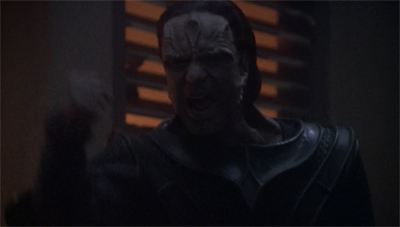
“Freedom!”
This is not an abstract question. The United States has been asking this question about the Middle East for decades, wondering how it might be possible to foster democracy and human rights in the region. As The Economist argues, direct foreign intervention in these cultures rarely has the desired effect:
These wrongs cannot easily or rapidly be put right. Outsiders, who have often been drawn to the region as invaders and occupiers, cannot simply stamp out the jihadist cause or impose prosperity and democracy. That much, at least, should be clear after the disastrous invasion and occupation of Iraq in 2003. Military support—the supply of drones and of a small number of special forces—may help keep the jihadists in Iraq at bay. That help may have to be on permanent call. Even if the new caliphate is unlikely to become a recognisable state, it could for many years produce jihadists able to export terrorism.
But only the Arabs can reverse their civilisational decline, and right now there is little hope of that happening.
Ferengi culture poses many of the same issues through a science-fiction prism. Ferengi values are radically different to those of the Federation, particularly with respect to concepts like female autonomy and personal rights. The status quo is not morally tenable, so how might thing change for the better?

Shadow play.
Deep Space Nine is cynical about Starfleet and the Federation, as demonstrated by episodes like The Maquis, Part I and The Maquis, Part II or Homefront and Paradise Lost. The series does not trust these large and faceless institutions. Even in The Dogs of War, Odo makes a point to condemn Starfleet for its passive complicity in the plot to wipe out the Founders. “They’re abetting genocide,” he states, simply. This accusation does not come out of nowhere. Picard realised in horror that the Federation readily would build a race of slaves in The Measure of a Man.
Indeed, it seems like one of the reasons why Deep Space Nine never followed up on Bajor joining the Federation is because of this fundamental distrust. This outlook was perhaps best expressed in a conversation about root beer between Garak and Quark in The Way of the Warrior, and reiterated in Michael Eddington’s parting message to Sisko in For the Cause. For all that the Federation represents liberal and democratic cultural values, Deep Space Nine insists that it will act in its own perceived self-interest to spread and enforce those values.

The man who would be Nagus.
It would be easy to conflate Deep Space Nine‘s skepticism about the Federation to a broader skepticism about the foundations of the Star Trek universe. Indeed, a lot of criticisms of Deep Space Nine make this mistake, insisting that the series’ deconstruction of the Federation and Starfleet represents a rejection of the utopian ideals of the Star Trek franchise. This is a very narrow perspective. Deep Space Nine is the only Star Trek show to look beyond Starfleet and the Federation, from Kira’s wariness in Emissary to Jake’s rejection of the Academy in Shadowplay.
Deep Space Nine rejects the idea that the Federation and Starfleet are the sole gatekeepers of utopia within the Star Trek universe, that their way of life is the only fulfilling and equitable option. In these final ten episodes, Deep Space Nine demonstrates its own utopian and optimistic bona fides. The Ferengi Alliance, the Cardassian Union and the Klingon Empire all take important steps towards liberalisation. However, these cultures do so on their own terms. Liberal values are not imposed from outside, they are fostered from within.
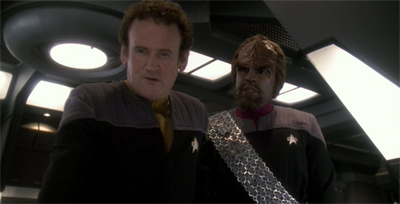
The Dogs of Worf.
Deep Space Nine is fundamentally optimistic about such change. Cultures can evolve, if there are enough people who are willing to ask tough questions. This is an interesting approach to liberalisation, perhaps one mirrored by Robert Cooper’s argument that democracy cannot be imposed by force of arms:
Can democracies develop without outside intervention? South Korea moved from a military dictatorship to democracy on its own, not as a result of great encouragement from anyone outside, in spite of the presence of American troops. Thailand has been more of a success story: there have been a couple of opportunities recently for the army to intervene in Thailand and they didn’t take them, which shows, although it’s imperfect, democracy is pretty well established. In Indonesia you could say that the IMF brought democracy – I don’t think that was intentional, but it had that effect. In South Africa, it was the international business community that forced change.
Deep Space Nine puts its faith in people, rather than institutions. The Federation invasion of Dominion territory helps, but it does not bring democracy to Cardassia. Democracy takes root on Cardassia when Damar dares to ask tough questions about the Union’s current predicament.

Ship shape.
The same is true the slow and subtle changes to Ferengi culture over the seven seasons of Deep Space Nine, which unfold without any direct interference from Sisko or Kira. Of course, not all of these transitions are elegant or logical. Profit and Lace remains a spectacular misfire, and it is hard to integrate The Emperor’s New Cloak into this arc. Even beyond quality, there are plotting issues. Ferengi Love Songs hinges on “small universe syndrome” of the highest order, and there are shades to that in Zek appointing Rom as his successor.
Still, the Ferengi stand as one of the crowning accomplishments of Deep Space Nine, the ultimate expression of the franchise’s esoteric approach to the Star Trek canon. On The Next Generation, the Ferengi represented a massive failure; they were a one-dimensional adversary introduced in the first season that never lived up to their potential. However, Deep Space Nine took these failed characters and explored them. Deep Space Nine gave the Ferengi a strange and unexpected dignity, Profit and Lace notwithstanding. The results were, by and large, compelling.
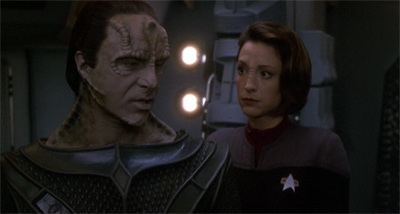
Homecoming.
Outside of the central plot thread focusing on the Ferengi, The Dogs of War is largely about lining up various plot threads for the big series finale. Some of these set-ups are decidedly inelegant. The Section 31 baggage from Extreme Measures is brought up in two scenes during the first act and then is quickly forgotten. The final push into Dominion space in What You Leave Behind is set up in the closing scenes of the episodes with little real explanation. These scenes feel obligatory and transitional, heavy-lifting that needs to be done.
However, there is also room for smaller character-centric scenes. There is something very touching in the final scene between Sisko and Yates, when Yates announces that she is pregnant. Brooks and Johnson have always played well off one another, but work brilliantly within this short scene. There is a wonderful push-and-pull between them, the duo caught between excitement and trepidation. Yates is happy to be pregnant, but afraid of what it might mean. Sisko is confused and happy. The scene is wonderful and human.
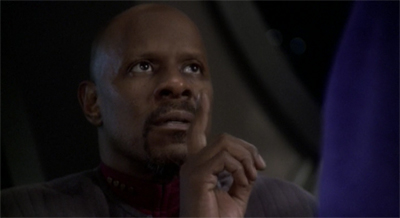
I don’t wanna emissary a thing…
Both Yates and Sisko try awkwardly to get a read on the other, to understand how their partner is really responding to this news. There is something very genuine in the fact that Yates is at once worried for her child and worried about how her husband will react. As anxious as Yates is, she clearly wants Sisko to be happy about the prospect of starting a family with her. “I’m pregnant,” she states. Sisko is surprised. “Are you sure?” he asks reflexively. Yates is defensive. “Of course I’m sure,” she responds. Sisko realises how that sounded, “Oh, baby, I didn’t mean…”
Sisko awkwardly tries to apologise for forgetting his birth control, glossing over the fact that a two-tier birth control method seems really inefficient. (Even if making responsibility for an unplanned pregnancy communal is a nice subtle feminist moment from Deep Space Nine.) Yates cuts through Sisko’s defensiveness. “You don’t have to apologise,” she states. He responds, “I’m not. Are you kidding? This, this is wonderful.” Somehow, that is also worrying to Yates. “I’m glad you think so,” she softly replies.

Dressing down.
The conversation lasts only a short scene at the end of the episode, but it captures so much of the humanity of Deep Space Nine, so much of the show’s understanding of people behave and feel. Yates doesn’t want Sisko to resent their child, but Yates also wants Sisko to share her worries. Yates would be offended if Sisko wasn’t a little excited about the pregnancy, but she is also concerned that he is not more worried. It is an emotional tightrope, but one that feels organic and genuine. These feel like two real people navigating a real emotional conversation.
To be fair, like the sequence about the invasion of Cardassia or like the conversations about attempted genocide, this short character sequence exists to set up What You Leave Behind. Deep Space Nine has shifted its focus away from Sisko and Yates in the second half of this sprawling ten-part finale. The conversation in the final scene of The Dogs of War marks the first appearance of Kasidy Yates since The Changing Face of Evil. As such, the sequence is a reminder of this core relationship going into the big series finale.

Pregnant pause.
According to Star Trek: Deep Space Nine Companion, the pregnancy was added at the behest of writer René Echevarria in his capacity as the writing room’s emotional bellwether:
“I remember saying to the others, ‘Okay, what’s the ‘sorrow’, guys? when Kasidy burns the peppers? Is that it?’ Because I just didn’t see it. ‘Is it because Sisko’s going to become a Prophet?’ And the others said, ‘Yeah, can’t you see that’s really sorrowful?'” But Echevarria reminded them that they’d tied Sarah’s warning to the fact that Sisko wanted to get married. And while one could make a case that Sisko’s having to leave his new wife would be a sorrowful thing, there were some flaws in the logic. “Sisko was going to have to leave Jake too,” he says. “So how was the sorrow marriage-specific? And even if he hadn’t married Kasidy, he’d still be leaving her and Jake behind.”
Echevarria decided on something that would do more than pay mere lip service to the concept of sorrow. He got Kasidy pregnant. “For me, that resolved the question of why the Prophets were warning him about marriage,” he says. “They knew it was going to lead to a child, and it would be truly sorrowful for Sisko to have to leave that behind.”
In terms of emotional leverage, the pregnancy is a clever choice. It allows for great emotional sorrow without resorting to something as crass as killing off Kasidy Yates.

Of course, the prophecy twist also relies on the audience buying that Sisko and Yates are having more sex after getting married. No prophecy is perfect.
Unfortunately, the other major relationship beat within The Dogs of War is nowhere near as effective as this short scene between Sisko and Yates. The Dogs of War follows through on a character beat that Deep Space Nine had been threatening for quite some time, pairing off Julian Bashir and Ezri Dax. On paper, this relationship ties back to the first season of the show, with Julian Bashir’s creepy pursuit of Jadzia Dax in episodes like Dax or If Wishes Were Horses… There was always a sense that Bashir was an over-enthusiastic young man who could not take a hint.
However, in the show’s middle seasons, Dax and Bashir became genuine friends. Bashir confidently asserted that he did not need the fantasy of a relationship with Dax to sustain him Distant Voices, entering a relationship with Leeta following Explorers. The two joked about their earlier dynamic when trapped together in a turbolift in Starship Down. Dax entered a relationship with Worf in Looking for Par’Mach in All the Wrong Places, and Bashir served as a Klingon equivalent to a groomsman at their wedding in You Are Cordially Invited…

Dax appeal.
On paper, this looked like a nice subversion of the typical “nice guy” romantic arc, where a male character who pines after a female character is all but assured to end up with her by the end of the story. There was a sense that Bashir and Dax had developed past his initial infatuation into friends. However, Deep Space Nine could no resist the potential character drama in that dynamic. During the sixth season, Bashir came to acknowledge that he was not over his missed opportunity with Dax. This played out as a subplot in Change of Heart and Tears of the Prophets.
To be fair, this was not the first time that the production team had played this particular card. Deep Space Nine followed a similar arc in the relationship between Odo and Kira. Odo acknowledged a crush on Kira in episodes like Necessary Evil and Heart of Stone, but accepted that it would never come to anything in Crossfire. Nevertheless, the series made a point to focus on this dynamic in episodes like Children of Time, and finally got Odo and Kira together in His Way. The final season found the production team doing something similar with Bashir and Dax.
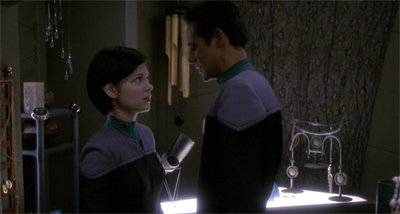
Together again, naturally.
Deep Space Nine uses the death of Jadzia Dax as a potential reset of this dynamic. When Ezri Dax arrived on the station in Afterimage, Bashir made a point to strike up their friendship again. Dax confessed, “You want to know something? If Worf hadn’t come along, it would have been you.” That set the tone for the relationship between the two characters. Worf was jealous of Bashir, and accused him of plotting to dishonour Jadzia’s memory. As the final arc got under way, the production team only ramped up the sexual tension.
Under Breen torture in ‘Til Death Do Us Part, Dax dreamed of Bashir; this became a source of tension with Worf. In Strange Bedfellows, Bashir confessed to missing her greatly during her absence. “There was something, something about her, wasn’t there?” he asks. “Something that made me happy, anyway.” It seemed inevitable that these two characters would end up together, amplified by scenes like their awkward interrupted conversation in When It Rains… Indeed, pairing off the two characters in The Dogs of War feels almost perfunctory.

(Ba)shir charm.
There is something inherently creepy in the decision to pair off Ezri Dax and Julian Bashir, something that treats Ezri Daz as a “reward” for Julian Bashir’s “patience” with Jadzia Dax. It plays into long-established romantic clichés that feed male entitlement. As Nico Lang explains:
From an early age, we’re taught bumper-sticker-ready lessons “never give up” and “if at first you don’t succeed, try, try again.” They offer us necessary lessons about the value of perseverance, but rarely do they illustrate the importance of consent. Rarely are we taught that it’s OK to try your best and not get what you want—because your desires aren’t the only ones that are important. Rarely are we taught that “no” deserves respect.
I can understand why people are drawn to stories like the “Romantic Pursuit” myth: We like success stories in which the little guy overcomes great odds to get what he wants, whether it’s working his way to the top of a Fortune 500 company or finally landing a date with the prettiest girl in the room. By championing these stories, we hope that will we be that underdog.
But while teaching tenacity is good, these myths have a dangerous side effect: They tell us love is something not that we earn but that we deserve simply through hard work. If we persist and do what we are told to do, we must be rewarded for our efforts—often at any cost.
Julian Bashir has spent relatively little time with Ezri Dax. They have had a handful of direct interactions with one another outside of group activities like Take Me Out to the Holosuite or Badda-Bing, Badda-Bang. As such, the dynamic between Julian and Ezri is overshadowed by the dynamic between Julian and Jadzia.

Checking the room on the Julian calendar.
What is it about Ezri specifically that appeals to Julian? What is it about the difference between Jadzia and Ezri that sparks his interest? Indeed, episodes like Melora and Chrysalis suggest that Julian might be drawn to Ezri by her confusion and her vulnerability, not out of some predatory impulse but out of Julian’s desire to help. The issue is not that Julian is being intentionally creepy or predatory. The issue is that this does not appear to be a fundamentally healthy dynamic between these two characters.
Indeed, what exactly does Ezri see in Julian? What aspect of Julian’s personality appeals to her, specifically? So much of Ezri’s arc across the seventh season is trying to find a proper balance in her life between the person that she is and the people who she was. There is a sense that becoming romantically entangled with a previous host’s best friend is not a healthy way to adjust to this new situation, even if it doesn’t violate the rules of Trill society established in Rejoined.

Staying on Ops of things.
This is not to suggest that the relationship between Julian and Ezri must be toxic or unhealthy. However, Deep Space Nine needs to do more to develop that dynamic than simply throwing them together in a turbolift so that these two characters can have a happy ending together. The union between Julian and Ezri feels sloppy and ill-considered, a very clumsy piece of storytelling with uncomfortable implications. It is one of the more profound creative missteps in this final stretch of the final season.
Still, this misstep aside, The Dogs of War holds together very well. The Dogs of War manages to move most of its pieces into the proper places before What You Leave Behind, and tell a self-contained story on its own terms. The Dogs of War pays off seven years of character development for the Ferengi, solidifying these most unlikely of aliens as the heart and soul of Deep Space Nine. In doing so, The Dogs of War properly contextualises the arc of history as it bends across the run of Deep Space Nine towards justice and liberalism.

“It’s Nag-me, not Nag-us.”
Deep Space Nine remains quintessentially Star Trek.
Filed under: Deep Space Nine | Tagged: capitalism, Cardassia, change, Dominion, ferenginar, Liberalism, Nagus, politics, Quark, star trek, star trek: deep space nine, the dogs of war, zek |




















Leave a comment